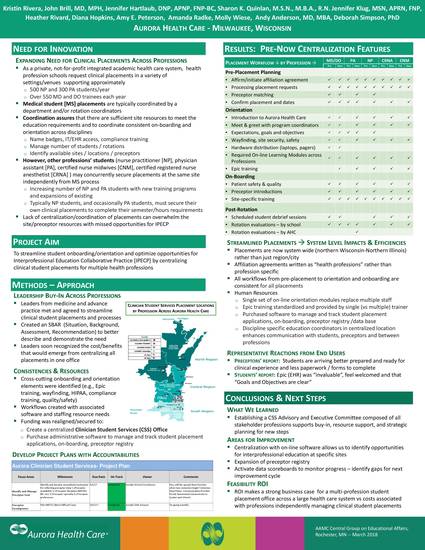
A Centralized Office for Clinical Students Placements across Professions is a Win-Win
Kristin Rivera, John Brill, MD, MPH, Jennifer Hartlaub, DNP, APNP, FNP-BC, Sharon K. Quinlan, M.S.N., M.B.A., R.N. Jennifer Klug, MSN, APRN, FNP, Heather Rivard, Dianna Hopkins, Amy E. Peterson, Andy Anderson, MD, MBA, Deborah Simpson, PhD
Objective
To streamline student onboarding/orientation and optimize opportunities for Interprofessional Education Collaborative Practice [IPECP] by centralizing clinical student placements for multiple health professions.
Background or theoretic framework/important
Students from multiple health professions require clinical training. Medical student [MS] placements are typically coordinated through by department/rotation coordinators assuring that there are sufficient site resources to meet the education requirements and to coordinate on-boarding and orientation (e.g., name badges, IT access, compliance training). However, other professions’ students (e.g., nurse practitioner [NP] and physician assistant [PA] may also secure placements at the same site independently from MS process potentially overwhelming site/preceptor resources with missed opportunities for IPECP.
Instructional methods and materials / how
Leaders from medicine, NP and PA met and agreed to streamline clinical student placements and processes. Leaders soon recognized the cost/benefits that would emerge from centralizing all placements in one office. Crosscutting onboarding and orientation elements were identified (e.g., EPIC training, wayfinding, HIPAA) and workflows created with associated software and staffing resource needs. Funding was realigned/secured to create a centralized Clinical Student Services (CSS) Office.
Educational Outcomes
STRENGTHS: 1,000 clinical student placements / year are now centrally managed. Preceptors and students are highly satisfied, reporting time saved and efficiencies. Students highly evaluate shared orientation and onboarding activities creating a positive “first impression” of the clinical placement. Centralization supports easy identification of learners by clinical site providing, in advance of learner arrival, opportunities for design of IPECP initiatives.
AREAS FOR IMPROVEMENT: Expansion of preceptor registry and electronic reporting data scoreboards.
FEASIBILITY: ROI reveals that the costs associated with professions independently managing clinical student placements makes a strong business case with single multi-profession placement office.
Rivera K, Brill J, Hartlaub J, Quinlan SK, Klug J, Rivard H, Hopkins D, Peterson AE, Anderson A, Simpson D. A Centralized Office for Clinical Students Placements across Professions is a Win-Win. AAMC-Central Group on Educational Affairs Annual Meeting. Innovation Medical Education. March 21-23, 2018. Rochester, MN.

Aurora Clinician Student Services
Academic Affairs